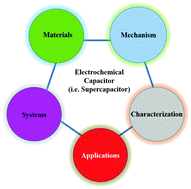Electrochemical capacitors: mechanism, materials, systems, characterization and applications
Abstract
Electrochemical capacitors (i.e. supercapacitors) include electrochemical double-layer capacitors that depend on the charge storage of ion adsorption and pseudo-capacitors that are based on charge storage involving fast surface redox reactions. The energy storage capacities of supercapacitors are several orders of magnitude higher than those of conventional dielectric capacitors, but are much lower than those of secondary batteries. They typically have high power density, long cyclic stability and high safety, and thus can be considered as an alternative or complement to rechargeable batteries in applications that require high power delivery or fast energy harvesting. This article reviews the latest progress in supercapacitors in charge storage mechanisms, electrode materials, electrolyte materials, systems, characterization methods, and applications. In particular, the newly developed charge storage mechanism for intercalative pseudocapacitive behaviour, which bridges the gap between battery behaviour and conventional pseudocapacitive behaviour, is also clarified for comparison. Finally, the prospects and challenges associated with supercapacitors in practical applications are also discussed.


 Please wait while we load your content...
Please wait while we load your content...